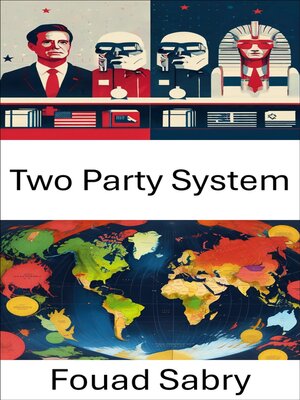Two Party System
ebook ∣ Dynamics of Bipartisan Politics and Governance · Political Science
By Fouad Sabry

Sign up to save your library
With an OverDrive account, you can save your favorite libraries for at-a-glance information about availability. Find out more about OverDrive accounts.
Find this title in Libby, the library reading app by OverDrive.



Search for a digital library with this title
Title found at these libraries:
| Library Name | Distance |
|---|---|
| Loading... |
Discover the intricacies of two-party systems with Two Party System, a comprehensive guide to the impact of two-party politics on governance. Explore key political concepts, election strategies, and historical milestones that have shaped the landscape of modern democracies. Each delves into a distinct aspect of two-party dominance and its challenges, offering insights into electoral systems, party dynamics, and political strategies.
1: Two-party system: Discover the principles and global influence of two-party systems on political stability.
2: Plurality voting: Understand how plurality voting reinforces two-party dominance in electoral systems.
3: Duverger's law: Explore Duverger's law and its impact on the formation of two-party systems.
4: Political parties in the United States: Analyze the rise of the Democratic and Republican parties in U.S. politics.
5: Party system: Compare two-party and multi-party systems, assessing their representational merits.
6: History of the Democratic Party: Trace the Democratic Party's evolution and its influence on U.S. politics.
7: Red states and blue states: Examine U.S. political polarization through the lens of red and blue states.
8: Split-ticket voting: Analyze split-ticket voting and its influence on party control and election outcomes.
9: Minor party: Evaluate the role of minor parties in two-party-dominated systems.
10: Electoral fusion: Investigate electoral fusion and its potential to disrupt two-party dominance.
11: 1848 U.S. presidential election: Revisit the significance of the 1848 election in shaping U.S. two-party politics.
12: 1852 U.S. presidential election: Reflect on the 1852 election's impact on party identity consolidation.
13: Free Soil Party: Study the Free Soil Party's role in shaping early American political discourse.
14: Electoral alliance: Explore strategic alliances and their effects on two-party dominance.
15: Political realignment: Investigate moments of realignment and their reshaping of two-party competition.
16: Vote splitting: Examine vote splitting's impact on election strategies and coalitions.
17: List of U.S. presidential candidates: Survey presidential candidates and their role in two-party system evolution.
18: Elections in Georgia (U.S. state): Explore Georgia's electoral trends and their interaction with national politics.
19: Elections in Brazil: Contrast Brazil's multi-party system with two-party dominance.
20: List of third-party performances in U.S. elections: Assess third-party impacts on American elections and two-party challenges.
21: List of unsuccessful major party candidates: Analyze the influence of unsuccessful presidential candidates on party dynamics.
Two Party System presents an essential exploration of political structures, showcasing how two-party systems shape governance and representation.







